
Featured Blog | This community-written post highlights the best of what the game industry has to offer. Read more like it on the Game Developer Blogs.
Artifact and the Five Currencies
A deep dive into Artifact's economy using the "four currencies" model, plus a fifth -- Skill!

So I've been playing Artifact, Valve's new card game designed by Richard Garfield (designer of Magic: The Gathering.) I've been in the beta for a little while, and have some thoughts on the game and it's much-ballyhooed economy.
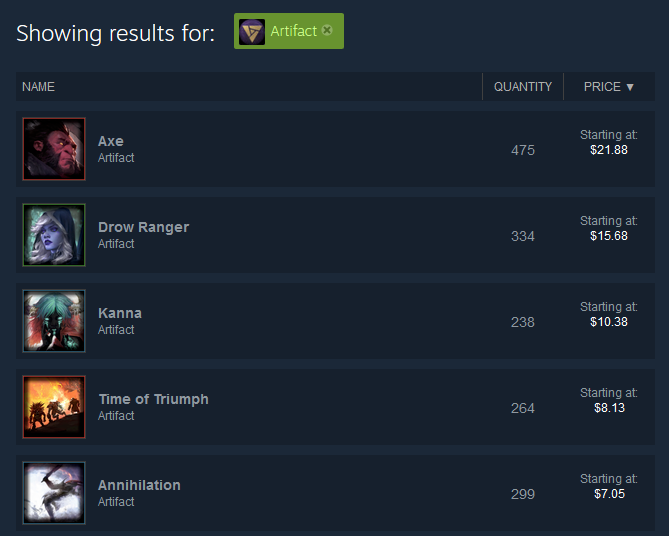
Earlier today I tried playing the market a little. You can read about that in this twitter thread if you want. The TL;DR is that there's both fascinating stuff, and causes for concern. (Also don't buy packs and learn to love casual phantom draft, but that's just me)
So I was in the Artifact beta, so I decided to use my base 10 packs as an experiment in playing the Artifact market. My limitation: no putting in any of my own money, see how far it gets me.
— Lars Doucet (@larsiusprime) November 30, 2018
The game itself -- just considering the gameplay and design -- is great. A whole bunch of articles have been written about the game design, how it plays, how to get started, etc, so I won't rehash that beyond basics: unlike every other card game I've played, it has three "lanes" of play at once -- kinda like three simultaneous games of Magic: The Gathering, albeit with different rules. Even considering deck advantage and lots of small-scale RNG, the general consensus is the game has a higher skill ceiling, so good play can overcome a superior deck (at least more than you'd expect from other card games). I exclusively play draft, and every game I've lost so far came down to a clear mistake on my part, with most games being very close with lots of exciting reversals. It's also faster-paced than most card games.
As for the economy, I have mixed feelings (and I don't mean "actually just negative feelings," as in common usage). There's both interesting and good things here as well as major concerns and pitfalls.
Academically, I'm fascinated by the market dynamics.
Socially, I'm worried about people with addictive personalities and compulsive gambling disorders.
Economically, the current model will probably lead to pretty cheap singles in the long run.
Cynically, I'm skeptical of constructed CCG formats b/c you always have to shell out one way or another just to not lose all the time.
Cheapskately, there's great game modes you can play free for ever.
Nervously, I worry about scamming and botting incentives.
Personally, I just play phantom draft casual, if I want constructed I'll play the pauper or peasant formats (only commons, and only commons/uncommons, respectively).
Valve has always been fascinated by market economies, and they've steadily been building out infrastructure on Steam to support it -- starting with the "hatconomy" in Team Fortress and CS:GO skins, to Steam Trading Cards. And of course, we've seen a fair share of scandals, bot farmers, and other scams over the years, drawn by the lure of financial incentive.
Unlike competing card games like Hearthstone and Gwent, Artifact costs $20 to play at all. (Hearthsone and Gwent are both free, but you can buy or grind for cards using in-game currency). This $20 buy in gets you 10 booster packs (each containing 10 cards each), five event tickets, and two preconstructed starter decks.
There are several game modes currently, which I will classify as "stakes" and "no stakes".
"Stakes" requires spending one event ticket, which costs $1 each (you must buy them in packs of five). Typically this is for an "expert gauntlet" where you try to win up to five games with the same deck. Losing two will end the gauntlet and forfeit your ticket. Winning three gets your ticket back, four nets you that and a free pack, and five nets you your ticket and two packs. Playing expert constructed obviously requires that you own cards, but there's also two draft modes -- phantom and keeper. Keeper lets you keep the cards you draft, but you have to pay for them, so it costs 5 packs and a ticket to enter. Phantom draft just loans you the cards for the duration of the gauntlet, so it only costs a ticket.
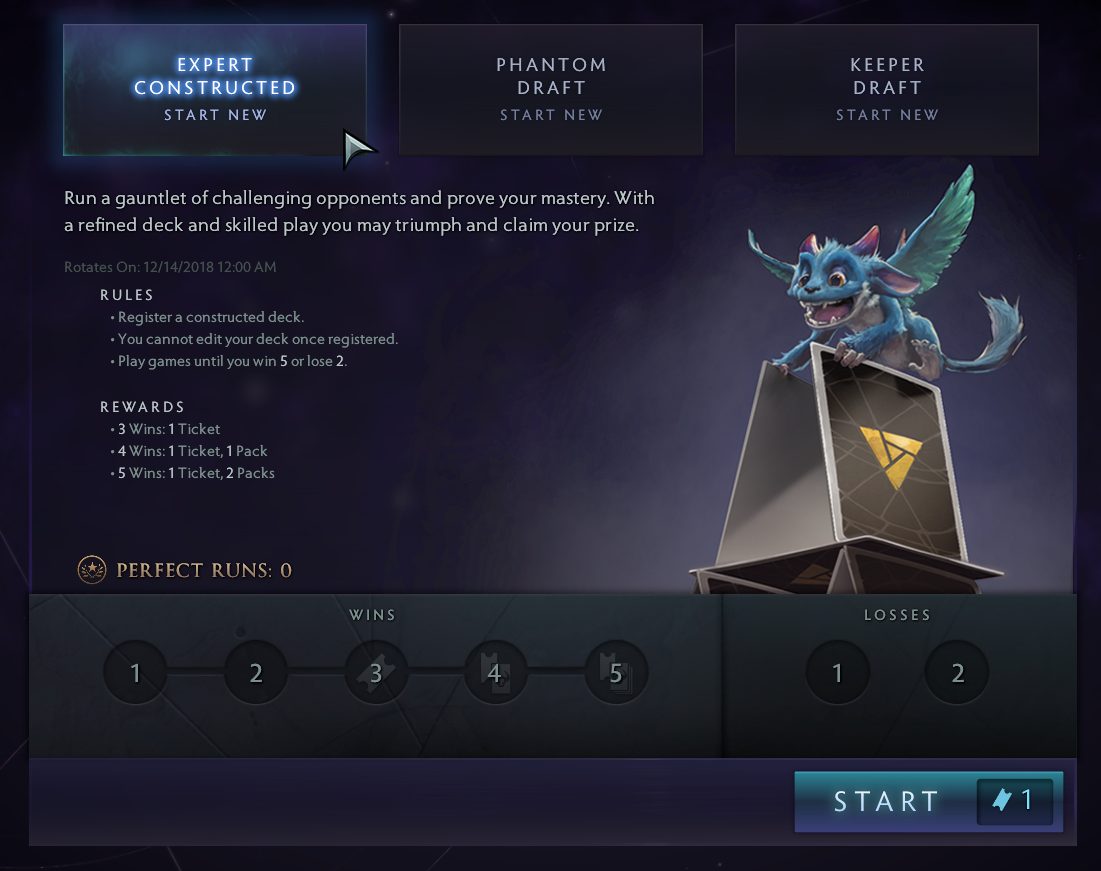
There's also "no stakes" versions of constructed gauntlet and phantom draft, as well as just a one-off casual constructed battle against a random matchmaking opponent at your skill level.
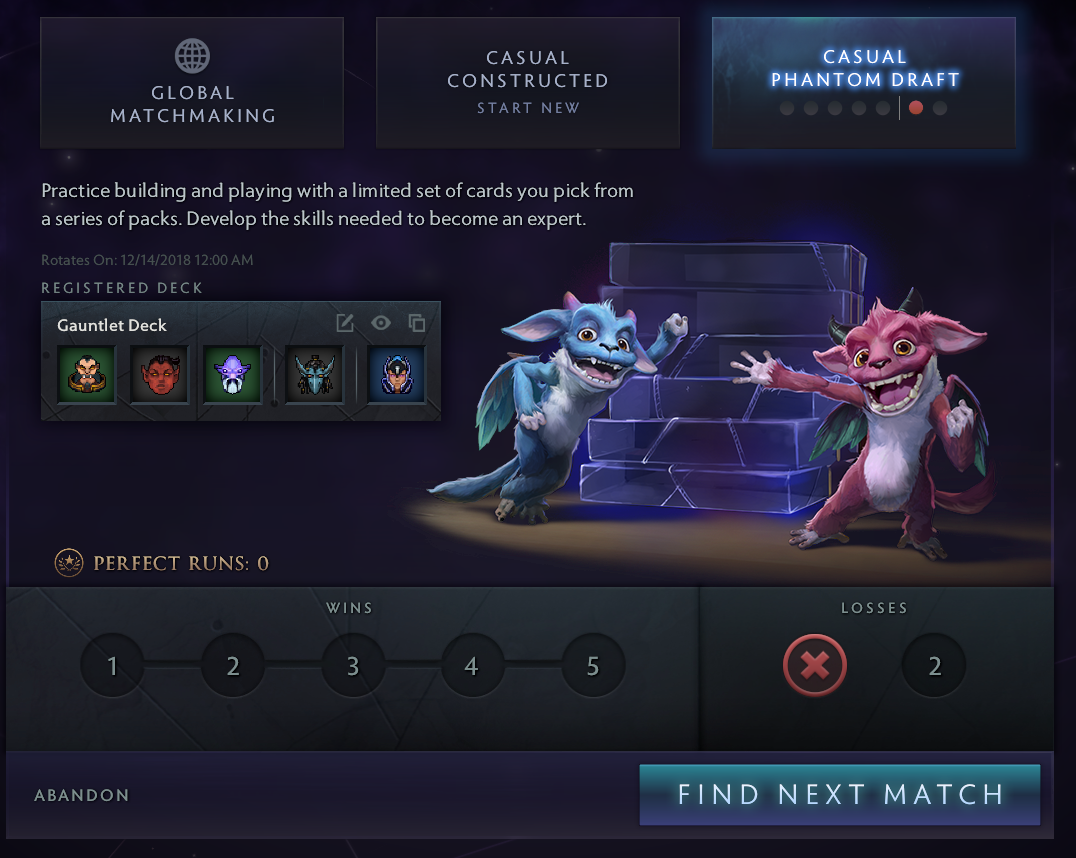
So, under what circumstances do you need to buy stuff to play Artifact? Let us count the ways:
To play the game at all ($20)
To play constructed (stakes or no stakes), unless you like losing a lot
To play keeper draft after you've run out of packs
To play any expert mode after you've run out of tickets
The two most common complaints about Artifact right now are:
There's a $20 entrance fee
There should be a free way to "grind" for cards like in other card games
There's valid arguments for the entrance fee and no grinding option, however. Note that by "valid arguments" I don't necessarily mean "correct", or "I agree" -- I mean, arguments that are logically correct if you grant the assumptions they depend on. Those assumptions are Valve's own goals and motivations, which I imagine are these:
Make a game with a marketplace because we want to do that as a first principle
Protect the market from scams
Make sure the value for everything doesn't go to literally zero
Granted these assumptions, an entrance fee and "no free grinding" necessarily follow. Because if you have a real money market place with no entrance fee to gatekeep, that market will be instantly destroyed by bots and scams spinning up new accounts. And if it's possible to grind for cards without putting stakes up, not only does that further incentivize scammers, but also just regular players will grind and dump cards until everything becomes worthless.
Plenty of people are okay with that, of course -- their true criticism is aimed at Valve's foundational assumption -- ie, that there should even be a market for cards at all.
But for better and/or for worse, Valve is committed to a marketplace and they're going to see this through. So let's follow this through to it's natural conclusions and explore all the angles.
Those of you familiar with my four currencies series can see where I'm going with this.
For those new to my blog, I get frustrated with how most economic discussions zero in myopically on just one "currency" -- money -- and neglect all the other equally valuable things we're "spending" in our day to day lives. In truth there are an infinite number of these "currencies", but the four I like to highlight most often are:
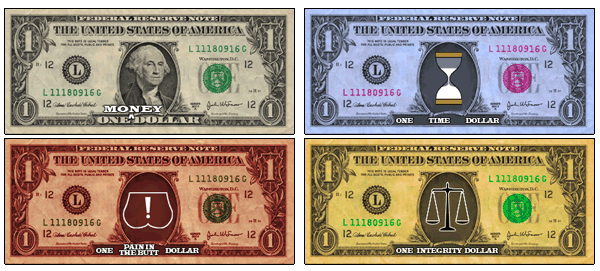
$M : Money dollars. Just regular money.
$P : Pain-in-the-butt dollars. Anything that's annoying, painful, or inconvenient "costs" these.
$T : Time dollars. Minutes and hours, these aren't free. You're gifted a finite, unknown amount and you never get them back.
$I : Integrity dollars. There's a real but intangible cost to most people for doing things they consider "wrong." And even people with unconventional moral compasses might still worry about getting in trouble with the law. Therefore, actions may have an "integrity cost" measured in guilt/concern/legal-risk/etc. This is highly subjective and varies from person to person -- but hey, so does the value of time, money, and pain tolerance.
The most famous of these articles is Piracy and the four currencies, where I assert that developers can compete with the "free" cost of piracy, by "selling" their game for lower amounts of the other three currencies, namely better and faster service ($P, $T), and at least for certain customers, not having the taint (or legal risk) or piracy ($I). Not everyone cares about those (or pirates wouldn't exist), but enough do that they'll gladly pay the developer/publisher's $M price rather than the pirate's $P+$T+$I price. It naturally follows that developers/publishers that treat customers like criminals are ratcheting up their $P+$T+$I price while also charging $M, destroying their competitiveness with pirates.
So let's apply the same principles to Artifact.
Artifact actually has five currencies in play. We need to add $S, or Skill dollars. Something that "costs" $S requires you to be good at something. This, along with $T, is what we typically sell to our bosses when we're working a day job (along with some $P depending on how much you hate your job, and $I, depending on how degrading it is).
For now I'm going to treat luck as its own thing rather than a sixth "currency" as you can't really "spend" luck in any meaningful sense -- it's out of your control.
Anyways, here's all the ways you can pay for stuff in Artifact, besides just money:
Skill dollars + Time dollars: Win gauntlets
If you can win thrice before losing twice in expert gauntlets, you break even on ticket costs. If you do better, you start earning packs. This is risky. If you start slipping, you burn tickets. Granted, tickets are pretty cheap at $1 apiece. There was some concern during the beta that Valve was juicing the match making so that you're doomed to lose. Let's investigate those claims, then evaluate what your chances actually are of paying your way with nothing but skill and time.
According to the FAQ match making is done based on two criteria: first, you are matched against opponents with the same win rate in their current gauntlet as you (so if you're 2 for 3, you'll face someone else who also has two wins and one loss), and within that pool of players you'll face someone of "loosely" matched skill. Subsequent clarification on twitter has Valve attesting that this matchmaking simply rejects wild differences in measured skill, rather than trying to artifically nudge win rates towards 50/50. For now we'll just have to take their word on that unless someone has an independent means of verification.
Regardless of who you play, you'll need to win 60% of your gauntlet games to break even, which means you're going to have to be a consistently better than average player to "go infinite." But even if you can win 60% of the time, a bad run can still cut you short. And keep in mind that as you go further in the gauntlet, you're facing people who have won more games, so "60% gauntlet game win rate" does not mean you have to be at the "60% skill percentile." Likely it means you have to be much higher. To give this a little context, I've won about 50% of my casual phantom draft gauntlet games so far, but I've yet to consistently win more than three times before losing twice. IE, I've lost far more of my second and third matches than I have my first.
In any case, I ran some tests using a simple monte carlo simulation that you can try yourself here:
Win rate | Average gauntlets | Average packs won | Infinite rate |
|---|---|---|---|
25% | 6 | 0 | 0% |
40% | 7 | 1 | 0% |
46% | 9 | 2 | 0% |
50% | 10 | 3 | 0% |
60% | 17 | 8 | 0% |
62% | 19 | 10 | 0% |
65% | 23* | 14* | 1% |
70% | 37* | 28* | 5% |
75% | 61* | 58* | 18% |
80% | 104* | 119* | 46% |
80.6% | 109* | 128* | 50% |
85% | 160* | 234* | 78% |
90% | 234* | 368* | 95% |
This is based on 100,000 iterations of the following program:
Start with 5 tickets
Repeatedly play gauntlets of five games each, win each game at a flat X% win rate, spend 1 ticket for each gauntlet
Collect rewards (+1 ticket at 3 wins, +1 pack at 4 wins, +1 pack at 5 wins)
Keep going until we're out of tickets or we hit "infinite".
"Infinite" here marks a hard cutoff just so the script doesn't crash from infinite loops. I calculate it by looking at the rolling average of the last twenty gauntlets -- if we have gone for at least twenty gauntlets and the number of tickets is increasing and we have more than 7 tickets, I cut it off there and assume you'll either keep winning forever, or at least have a big haul before eventually going bust. This means that the average gauntlets played / average packs won are depressed for the figures marked with an asterisk -- if I had no cutoff they would probably be much higher.
So how good do you really have to be to "go infinite?" Well it depends on what you mean. If you mean "make my script crash from an infinite loop", you need to have an 80.6% flat win rate to have at least a 50% chance of it happening.
That's a tall order -- you need a 30.6% better flat winrate than everyone else playing Artifact to pull that off, adjusted for the matchmaking ramp. But you don't have to be quite that good. In fact, you can be worse than average in terms of flat win rate and, in the long run, keep playing expert gauntlets without running out of tickets.
The minimum threshold is probably a 46% flat winrate. You'll lose more games than you win, but on average you'll break even or better long enough to play 9 gauntlets on average, and net about 2 packs. That doesn't sound great, but Artifact lets you recycle cards for tickets at a rate of 20 cards per ticket. There's 10 cards in each pack, so if you completely ignore the contents, you can dust 2 packs for a ticket. You'd probably be smarter to sell them on the market as you're guaranteed a rare in each pack, and analysis suggests the expected value of a pack should hover around two bucks, and a ticket only costs one. So at 46% flat winrate you can start with 5 tickets, and end up with between 1 and 4 from your packs, depending on market value. At 62% flat winrate the model suggests you can dust your winnings regardless of market value and always end up with as many tickets as you started with. (Again, this is the long run, and it's an average -- local variance probably means plenty of people will just go bust off a single attempt to run until their tickets go out).
EDIT 12/3/2018 9:38 AM: Looks like commodity commons sometimes get as low as $0.03 to purchase. So if you can get $4.00 for selling 2 packs, at $0.03/card you can convert that to 133.33 "ticket fodder" cards which can be recycled for 6.67 tickets. I don't expect such price dips to last particularly long, but they seem to happen now and then. At $0.04/card you can get exactly 5 tickets worth of cards.
And again, there's a world of difference between a flat 46% winrate and the 46th skill percentile, because not all matches are created equal -- the fifth battle in a gauntlet is going to be way tougher than the first, on average. Even though Valve claims that the MMR will make it slightly more likely for lucky schlubs to face off against other lucky schlubs rather than being exclusively stomped by experts, the selection effect of pitting people with the same gauntlet win rate against each other will dominate. I don't know how much to adjust things by there, but it seems safe to assume less than half the players have what it takes to "go infinite."
(I did some fancier simulations that try to account for the inherent matchmaking ramp of gauntlets, and got some preliminary results that suggest my intuition here was correct. If you want a look at my scripts, I've put them up on Github.)
Time dollars + Pain-in-the-butt dollars: Liquidate your steam trading cards
Believe it or not, there is actually a """free""" way to """grind""" for Artifact cards!
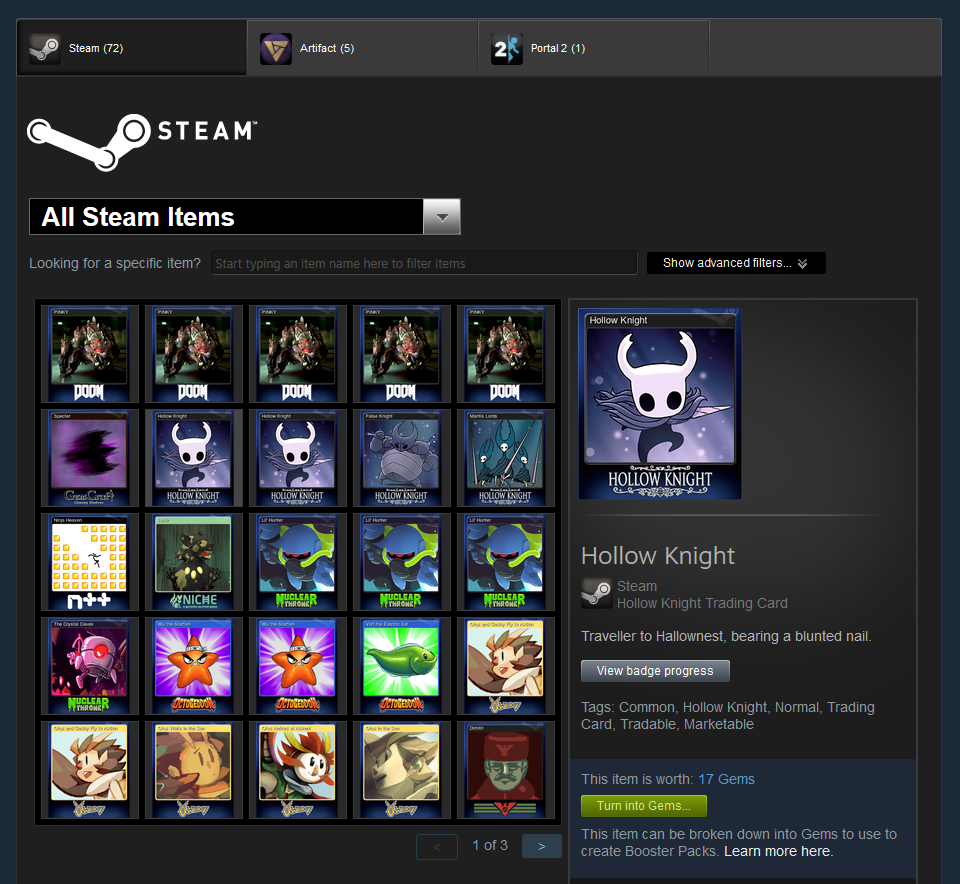
Have you put any money into Steam games ever? Does your Steam inventory look like this? Do you care about any of this stuff? Turns out I had several bucks worth of stuff in here. I don't care about "leveling up my steam profile" or badges or points or whatever, so off to the market it goes.
Granted it's not exactly """free""" because only paid games, and F2P games you've spent money in, will drop trading cards. So money has to have entered the equation somewhere in your history.
The chief difference between the Artifact market and the generic Steam trading card market is that the latter is a tremendous pain to use. With the Artifact market, as long as you've had your mobile authenticator authorized for seven days, you can list cards on the market in bulk, at the market rate most likely to sell them immediately, and they're liquidated in seconds. You need one mobile authentication for the first sale, as well as individual confirmations for high value cards, but that's it.
For Steam Trading cards, you need to click on each one individually, wait for the little widget popup to load, inspect the market price, subtract one cent from it, punch in the number, hit "confirm", dismiss a popup, and then go to your mobile authenticator and hit "confirm" for that transaction when it pops up 10 seconds later. Unless the mobile app bugs out, which it does all the time, and you have to refresh the confirmation page. You have to do this for every transaction, even to sell something worth $0.01.
Apparently there's some tools that make this stuff easier, but just using the Steam interface itself it's a pain, and unless you have literally nothing better to do with your time, most steam trading cards and booster packs aren't worth enough to make it worth your time and money. But, if you have a backlog of cards, and you really feel the urge to "grind" for Artifact cards, you can totally do this.
In fact, this is one of my points of concern. Steam trading card bots were a major exploit vector behind the "fake games" crisis with greenlight and Steam Direct. Basically, fly-by-night "developers" would put super low-effort "games" on Steam, price them as low as possible, add trading cards, then mass-buy them with bot accounts to grind for cards, which they then sold on the market at a profit. Valve has clamped down on this practice now as I mentioned earlier, but the Artifact market opens a new financial incentive for "cashing out." Before, the only thing that gave trading cards inherent value was the few random people on Steam who seem to care about blinging out their Steam profile by collecting and redeeming them. But now that economy is connected, however indirectly, to Artifact cards, because both are fungible commodities. Valve would be advised to be on high alert for new and exotic scams and exploits here.
Money dollars
Of course, you can still just buy your Artifact cards using plain old fashioned money. If you go this route, I highly recommend you do it by purchasing singles rather than opening packs (you can see the twitter thread for a deep dive on that -- see if you can catch the part where I accidentally overestimate the EV of a booster pack by linking the wrong script!).
This is the part I actually kind of like about Artifact. If given the choice of grinding for hours and hours and hours (as many are proud to proclaim about Gwent and Hearthstone -- "I never paid a cent!") to earn your cards, or buying booster packs at inflated prices and hoping to get the cards I want, I would much rather just buy exactly the cards I want.
At this stage of my life, my time is super valuable. Grinding is a waste of my precious time, and opening packs is a waste of my money and an assault on my integrity because I've got a bad compulsive streak. Maybe you're in a different place -- I respect that, to each their own.
So as disturbed as I am by booster packs in Artifact, I love that they aren't the only way to spend money if I ever want to play constructed. And for what it's worth, it looks like most cards are going to be pretty cheap. Granted, the good rares are a bit pricey, but there's good reason to expect those prices tocome down.
The reddit.com/r/artifact community has put together some really interesting scripts, check these out:
Average price of common, uncommon, and rares, and expected value of a booster pack
As of this writing:
Common: $0.05
Uncommon: $0.14
Rare: $1.54
EV of a pack: $2.37
Cost to buy a full set of every card as singles
As of this writing: $289
There are four "hard" forces beyond simple supply and demand that control the evolution of Artifact card prices.
You can dust any 20 cards for an event ticket
You can buy a booster pack at any time for $1.99
Valve charges a fee for every transaction (buyer pays face value, seller gets less than the purchase price)
There is no limit to how many cards can enter the market through opening booster packs & winning gauntlets
Dusting cards for tickets implies that no card should ever be worth much less than $0.05 to buy. Because of Valve's fee, the lowest you can practically list for and still make $0.01 is $0.03. If commodity cards are available for $0.03 or $0.04, it becomes cheaper to buy these up and dust them for tickets than to buy tickets themselves, so this should tug the price slighly up from the bottom. Cheap cards holding some value serves to depress the ceiling of rare prices because both are found in a booster pack.
On the other end, there's a limit to how expensive good rare cards (Axe, Kanna, Drow Ranger, etc) can get. If Axe & Kanna were to climb in price forever, for instance, there's some chance of spawning those cards in a pack, which brings up the average expected value of a pack. This means that it becomes profitable for whales and speculators to start mass-opening packs -- as long as good rare cards stay expensive, the law of averages means they'll eventually draw those big cards and they'll make a profit on their openings. Of course, the market doesn't stay stable for long, so as soon as we see rare prices climb, we should expect a rush of new supply to follow, depressing the value of these big cards. Once the EV of a pack goes below the $1.99 purchase price, it no longer makes sense to buy them just to play the market, supply dries up, and demand starts to rise again.
I strongly advise against opening packs in an attempt to "play the market" because even if you spot a spike in EV, you're likely to be bitten by a few things:
Valve's trading fee. This can eliminate your profit margin entirely, even if you hit the big drops.
It's pretty addictive and compulsive. It's easy to get sucked in no matter how "rational" you think you're being. This is the part of it I honestly like the least. It's so easy and frictionless to liquidate your inventory and buy packs over and over.
Market fluctuation. If you saw an EV spike, all the other folks did too, and it won't take long until people rig up high-frequency trading algorithms that autopilot their steam accounts for them. If there's real money to be made here, it's going to be made by the professionals, and that's probably not you.
Local variance. Even if you have a high EV, and you're willing to play the long game, local variation in random outcomes is probably going to eventually deplete your Steam credit and require you to put new money into your wallet.
Steam Credit. Once money enters the Steam ecosystem, it can never leave. So if you're already planning on buying games or whatever with that money, fine, but you should not treat Steam credit as actual money. If you spin $15 into $50 of Steam credit, but you temporarily bottomed out enough to have to put $15 of new money into Steam to get there, in terms of real money out of your pocket you're not up $35, you're down $15. But enjoy the Steam credit and buy yourself something nice?
All said, I would expect a slow but steady drop in card prices as the tug of infinite potential supply outweighs the balance of EV. Also, I doubt every trader is going to be "rational" in the economically narrow sense of the term -- somebody wants to run a Meepo deck no matter how underpowered he is in the meta, some people will instantly sell all their cards at market rate and play phantom draft forever, some people will make baffling and terrible market offers for no good reason. The exact mix of players is what determines the shape of the market, with the price of powerful rare cards most closely tied to what % of players want to play top tier constructed decks.
NO dollars
You know what else you can do? NOT buy anything, and don't shell out a single unit of time, money, pain-in-the-butt, integrity, OR skill. I happened to luck into getting the game from the beta, but I have to say I'd gladly pay $20 just for the base "no stakes" modes.
My personal favorite is casual phantom draft. Not playing constructed means I'm not going up against super powerful decks played by the most obsessive players, and I'm on a more or less level playing field just trying to put together a deck out of whatever I draw, with the game coming down to my drafting + playing skills.
Or if drafting / deck construction is too much, play the current featured gauntlet -- "Call to Arms", and just pick a preconstructed deck. You're guaranteed to go against one of the other preconstructed decks, and they're all at about the same power level. So here the winner is totally down to skill.
Of course, there's no progression system or rankings or whatever (yet, Valve says they plan on adding some as their top priority). I get this is very important for some people. I am not one of them. For me the joy of a game is in the game itself, and I find Artifact -- economy aside -- to be very well designed indeed. I don't need a number to tell me how good I am, and I don't need to drop a lot of money to prove myself to anyone, either. $20 is pretty cheap for a game with this kind of production values, and I'm happy to just play casual phantom draft forever.
Please, though, Valve. Add a casual 1v1 phantom draft option. So I can play my friends rather than strangers.
Read more about:
Featured BlogsAbout the Author(s)
You May Also Like







